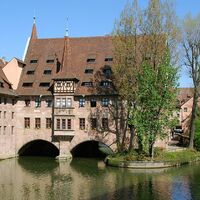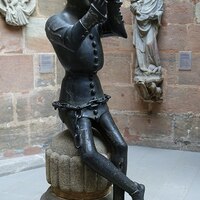Holy Spirit Hospital, Nuremberg
Type:
Secular architecture,
Sculptures,
Tombs
Date:
hospital 1332–39,
tomb 1356,
boy playing shawm 1380
Location or Findspot (Modern-Day Country):
Germany
Medium:
Brass
Dimensions:
boy playing shawm H 121 cm
Description:
This hospital in Nuremberg was the largest privately endowed foundation in the Holy Roman Empire. It was built on family property by a wealthy entrepreneur, Konrad Gross, who placed it under the authority of the city council. Erected between 1332 and 1339 "for the good of his own soul and of his parents, friends, and benefactors," the hospital was intended to care for 128 sick and 72 elderly people. Its buildings, with steep gabled roofs, were grouped around courtyards lined with arcades and second-floor galleries. Two wings supported by low arches still extend out to an island in the river.
Beginning in 1423, the church in the hospital complex housed the Holy Roman imperial regalia and sacred relics that had once been kept at Karlstejn Castle. Among the regalia were the coronation robes that previously belonged to the kings of Norman Sicily. The relics included the Holy Lance that had pierced Jesus's side at the Crucifixion and a piece of the True Cross. These relics were kept in a large shrine suspended by iron chains in the choir of the church. On the second Friday after Easter, and on other days when there were special visitors, the shrine was let down and the contents displayed for veneration. When crowds of pilgrims became too large, this display was moved to a nearby market building. In 1796 the relics and regalia were moved to Vienna. The church was destroyed in the Second World War.
The tomb of Konrad Gross (d. 1356), originally placed before the main altar of the church, is now reconstructed in the hospital. It depicts eight mourning figures around the effigy of the deceased holding a model of his foundation. More unusual is a large, hollow figure of a boy playing a shawm that was installed about 1380 as a fountain in the hospital's north courtyard; the water emerged from the instrument. He wears the typical dress of elite men in Europe in the later fourteenth century. Except for the shawm (made of lead) and the chain belt, the brass figure was cast in one piece and then brightly painted. The work is unusual because of its material and technique (brass casting at this scale was exceptional at the time), its secular subject, and its conception as a freestanding figure to be viewed in the round. The figure may have been a symbol of youthful good health, an inspiration in its hospital setting.
Beginning in 1423, the church in the hospital complex housed the Holy Roman imperial regalia and sacred relics that had once been kept at Karlstejn Castle. Among the regalia were the coronation robes that previously belonged to the kings of Norman Sicily. The relics included the Holy Lance that had pierced Jesus's side at the Crucifixion and a piece of the True Cross. These relics were kept in a large shrine suspended by iron chains in the choir of the church. On the second Friday after Easter, and on other days when there were special visitors, the shrine was let down and the contents displayed for veneration. When crowds of pilgrims became too large, this display was moved to a nearby market building. In 1796 the relics and regalia were moved to Vienna. The church was destroyed in the Second World War.
The tomb of Konrad Gross (d. 1356), originally placed before the main altar of the church, is now reconstructed in the hospital. It depicts eight mourning figures around the effigy of the deceased holding a model of his foundation. More unusual is a large, hollow figure of a boy playing a shawm that was installed about 1380 as a fountain in the hospital's north courtyard; the water emerged from the instrument. He wears the typical dress of elite men in Europe in the later fourteenth century. Except for the shawm (made of lead) and the chain belt, the brass figure was cast in one piece and then brightly painted. The work is unusual because of its material and technique (brass casting at this scale was exceptional at the time), its secular subject, and its conception as a freestanding figure to be viewed in the round. The figure may have been a symbol of youthful good health, an inspiration in its hospital setting.
Relevant Textbook Chapter(s):
9,
10
Repository and Online Resources:
• The relics shrine is now in the Germanisches Nationalmuseum in Nuremberg (KG187).
• Zoom in on the sculpture of the boy playing a shawm here.
Image Credits:
Wikimedia Commons




